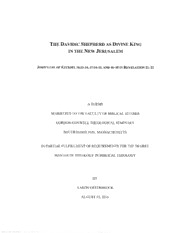
The Davidic shepherd as divine king in the New Jerusalem: John's use of Ezekiel 34:23-24, 37:24-25, and 40-48 in Revelation 21-22 PDF
Preview The Davidic shepherd as divine king in the New Jerusalem: John's use of Ezekiel 34:23-24, 37:24-25, and 40-48 in Revelation 21-22
ABSTRACT This study will examine the relationship between Ezekiel and Revelation when it comes to the portrayal of the Divine Presence in the eschatological holy city labeled respectively by each, "The Lord is There" or the "New Jerusalem." John not only borrows frequently from the final vision of Ezekiel (Ezek 40-48) to describe his final vision (Rev 21-22), but he alludes to Ezekiel throughout the Apocalypse. John's allusions often add significance to Ezekiel's initial meaning. The most substantial example of this is found in John's treatment of the Ezekielian Davidic Shepherd (Ezek 34, 37, cf. 44-46). John demonstrates Jesus to be the Davidic Shepherd as well as the Divine Presence. John, in the same vein as Ezekiel, also portrays the Divine Presence as King throughout Revelation, especially in his final vision of the fully inaugurated Kingdom. The combining of John's portrayal of the Davidic Shepherd as the Divine Presence, through Jesus, and the Divine Presence as King results in the main argument of this thesis: the Davidic Shepherd is Divine King in the New Jerusalem.
